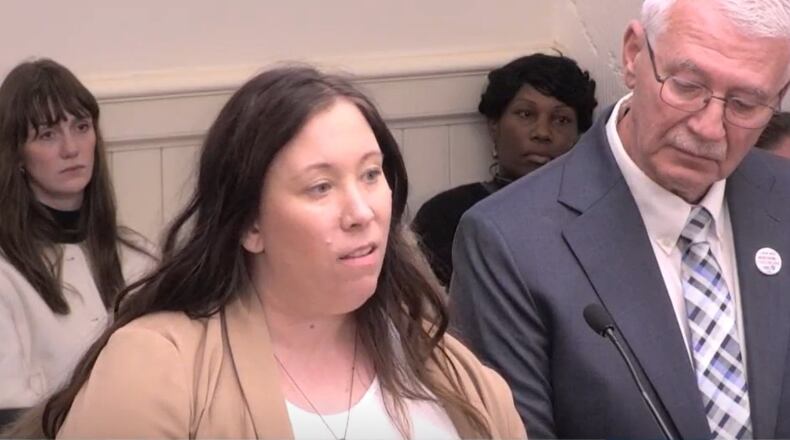“Proper staffing is more than a logistical goal—it’s a matter of life and death for our patients and the professional sustainability of the nurses who care for them,” said Catharyne Henderson, a nurse with 11 years of experience..
The proposed legislation would set staffing ratios depending on the hospital setting, ranging from one patient per nurse up to six patients per nurse, according to the bill’s analysis.
Nurses point to patient safety
Hospital systems that oppose the legislation often reference costs, and one legislator got right to the point.
“I represent the Cleveland area (with) one of the largest hospital systems in Ohio,” said Ohio Rep. Darnell Brewer-D-Cleveland. “They came to me about this bill―what do you say to them when they tell me as a legislator that this bill would increase costs?”
“I would like to say to them―or have you say to them―what’s the cost of a human life? What cost is safe staffing?” said Tony Sopko, president and chairman of UAW Local 2213 Professional Registered Nurses out of Toledo.
Those who testified repeatedly emphasized that staffing ratios are about more than the nurses’ mental and physical wellbeing―it is also about their patients’ wellbeing.
Exposure to shifts with high levels of registered nurses had lower odds of mortality by 8.7%, according to one longitudinal study published in the International Journal of Nursing Studies.
Low staffing was associated with higher odds of mortality by 10%, according to that same study. The associations between mortality and staffing by other groups were less clear.
In 2023, nurses submitted more than 2,600 Assignment Despite Objection (ADO) reports to the Ohio Nurses Association, documenting unsafe conditions in hospitals with the majority dealing with what they saw as inadequate staffing, said Rick Lucas, a critical care nurse, as well as president and executive director of the Ohio Nurses Association.
“Minimum staffing standards reduce complications, improve patient satisfaction and decrease readmissions,” Lucas said. “These all cut costs for hospitals in the right way.”
Nurse penned emotional letter prior to her death
Family members of Tristin Kate Smith — a Dayton nurse who died by suicide on Aug. 7, 2023 — also talked before the House Health Provider Services Committee, reading a letter Tristin had written about strain the nursing profession had on her. Her father, Ron Smith, found the letter on her laptop after her death.
“From a young age, Tristin always wanted to take care of people,” said Ron Smith, of Oakwood. “She fulfilled that a dream―a dream that ended up taking her life.”
Nurses are burnout and it has an effect on patient care, Ron Smith said.
“I think that’s what everyone’s saying is, there’s a problem, and they’re telling you how to fix it,” said Sarah Smith, Tristin’s sister. “Yes, money’s an issue. But you know what? I did a quick Google search and the CEO of the hospital that my sister worked at, his base salary is $1.6 million with $400,000 of bonuses.”
Last year, the Dayton Daily News found that former CEOs of Dayton’s largest adult hospital systems received base salaries over $1 million throughout the pandemic and bonuses totaling more than $2 million in 2021.
“You know what my sister did?” Sarah Smith said. “She bartended on the weekends because she couldn’t pay her bills and sat in the bathroom eating her sandwich because that was when she could take her lunch.”
‘I find it difficult to feel much sympathy’
Short staffing and high workloads were a problem prior to the COVID-19 pandemic, the nurses who testified said, but the pandemic became the breaking point for this issue.
“I hope everybody got to enjoy their lunch. I know that it’s a little bit later in the day, and I’m sure you’re all tired as evidenced by you’re dropping like flies here,” said Kylee Ham, who has been a nurse for more than 10 years.
Ham referenced the representatives―including Ohio Rep. Tom Young, R-Washington Twp., who sits on the Health Provider Services Committee―who left during the committee hearing before she and the Smith family got to give their testimony. This newspaper reached out to Young for a comment.
“I find it difficult to feel much sympathy,” Ham said. “I can count on one hand the number of uninterrupted 30 minute lunches I have taken during my 12 hour shifts over the last three years, and I would still have two fingers left to palpate for a pulse.”
No opponents of the bill testified in person during the committee hearing. The presidents and CEOs of the Ohio Hospital Association, Ohio Chamber of Commerce, Ohio Business Roundtable and Ohio Children’s Hospital Association all signed submitted testimony opposing HB 285.
“In a time of unprecedented labor shortages, especially in industries requiring highly technical and clinical-based training, mandating staffing ratios only creates more disruption in a historically unstable labor market,” Emma Cardone, director of advocacy at the Ohio Hospital Association, said in the testimony that was jointly signed by those associations.
About the Author



